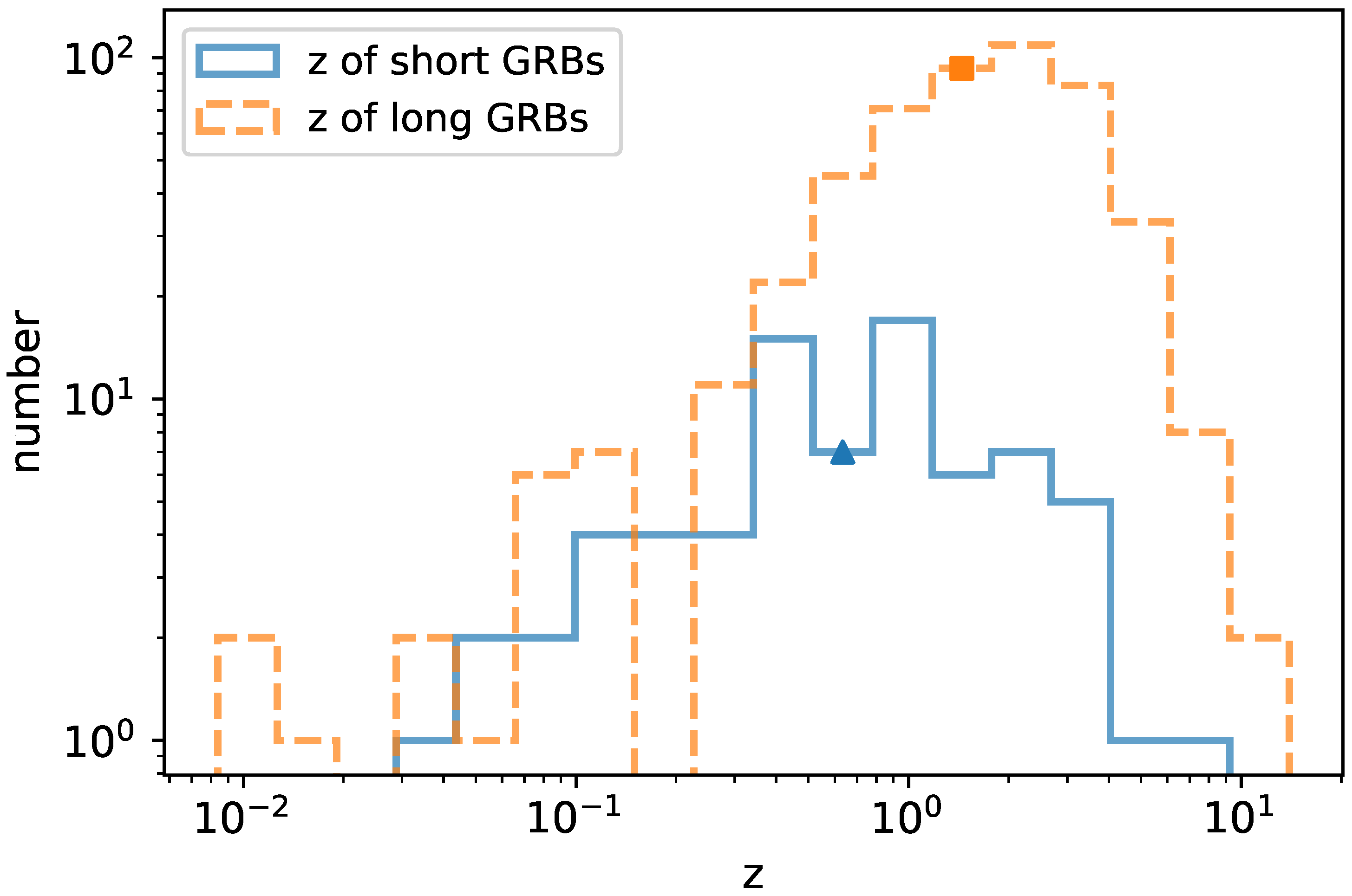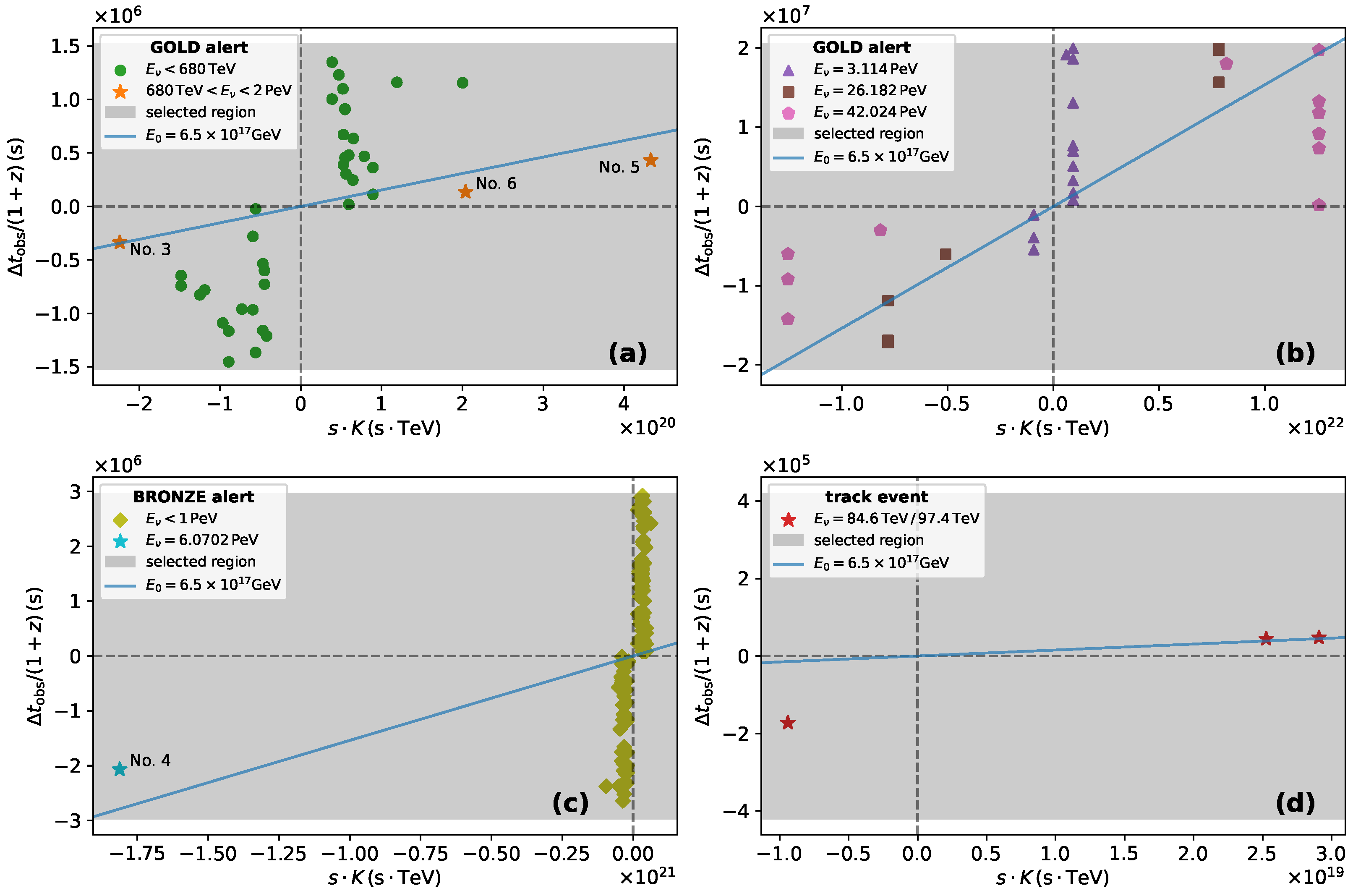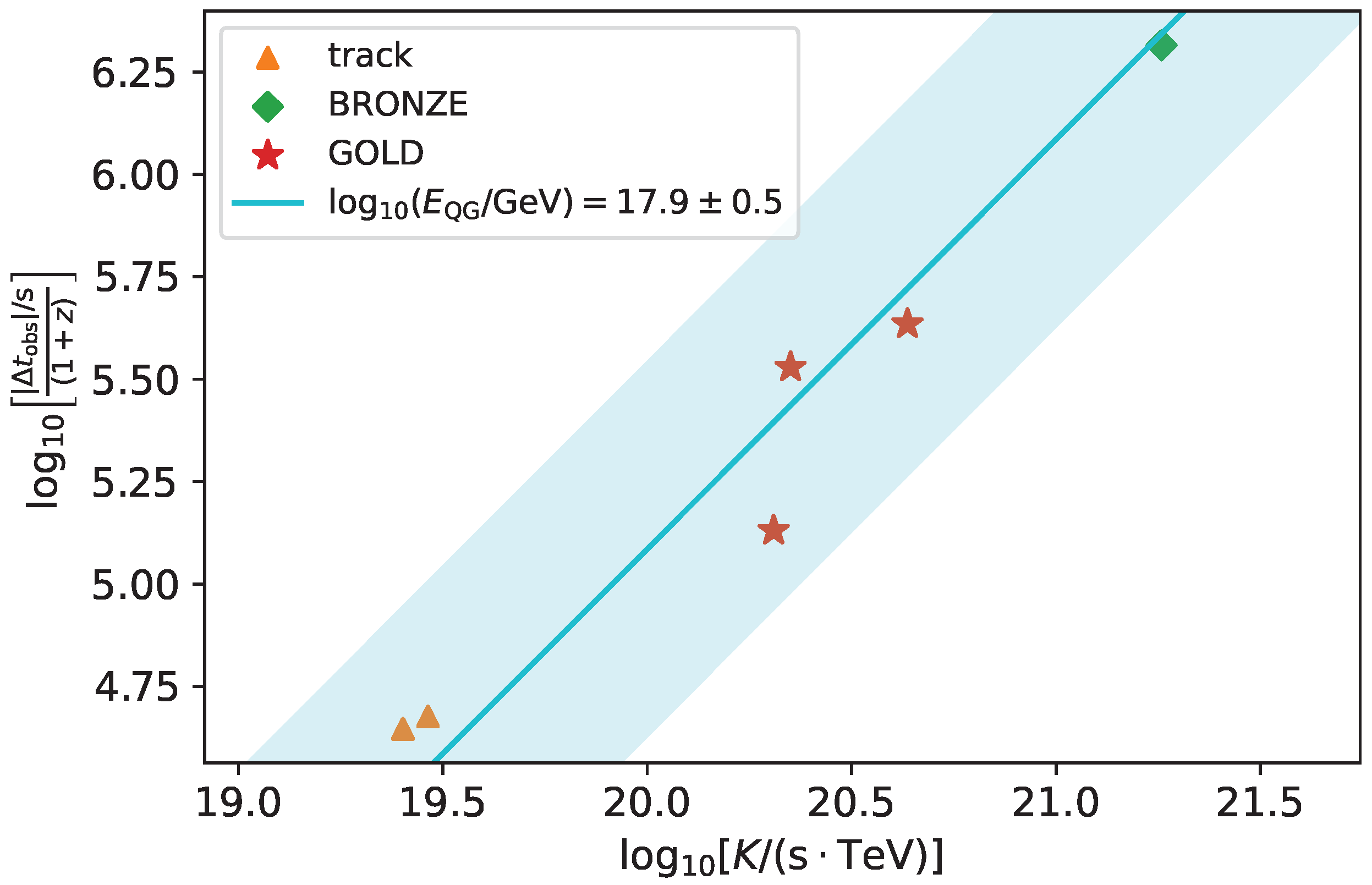Testing Lorentz Violation with IceCube Neutrinos
Abstract
1. Introduction
2. Data sample
2.1. IceCube Neutrino Events
2.2. GRB Catalog
3. Theoretical Model
4. Analysis Methods
- The angular distance between neutrino and GRB events should not be larger than , where and are the angular uncertainties of GRB and neutrino events separately.
- should be within a specified selection window, which is calculated based on the initial value of , as described below.
5. Results
6. Discussion and Conclusions
Author Contributions
Funding
Data Availability Statement
Acknowledgments
Conflicts of Interest
References
- Abdo, A.; Ackermann, M.; Ajello, M.; Asano, K.; Atwood, W.B.; Axelsson, M.; Baldini, L.; Ballet, J.; Barbiellini, G.; Baring, M.G.; et al. A limit on the variation of the speed of light arising from quantum gravity effects. Nature 2009, 462, 331–334. [Google Scholar] [CrossRef]
- Du, S.S.; Lan, L.; Wei, J.J.; Zhou, Z.M.; Gao, H.; Jiang, L.Y.; Zhang, B.B.; Liu, Z.K.; Wu, X.F.; Liang, E.W.; et al. Lorentz Invariance Violation Limits from the Spectral-lag Transition of GRB 190114C. Astrophys. J. 2020, 906, 8. [Google Scholar] [CrossRef]
- Xu, H.; Ma, B.Q. Light speed variation from gamma ray burst GRB 160509A. Phys. Lett. B 2016, 760, 602–604. [Google Scholar] [CrossRef]
- Huang, Y.; Ma, B.Q. Lorentz violation from gamma-ray burst neutrinos. Commun. Phys. 2018, 1, 62. [Google Scholar] [CrossRef]
- KosteleckÝ, V.A.; Russell, N. Data Tables for Lorentz and CPT Violation. In Proceedings of the 4th Meeting on CPT and Lorentz Symmetry, Bloomington, Indiana, 8–11 August 2007; pp. 308–321. [Google Scholar] [CrossRef]
- Kostelecky, V.A.; Samuel, S. Spontaneous Breaking of Lorentz Symmetry in String Theory. Phys. Rev. D 1989, 39, 683. [Google Scholar] [CrossRef]
- Amelino-Camelia, G.; Ellis, J.R.; Mavromatos, N.E.; Nanopoulos, D.V.; Sarkar, S. Tests of quantum gravity from observations of gamma-ray bursts. Nature 1998, 393, 763–765. [Google Scholar] [CrossRef]
- Gambini, R.; Pullin, J. Nonstandard optics from quantum space-time. Phys. Rev. D 1999, 59, 124021. [Google Scholar] [CrossRef]
- Vasileiou, V.; Jacholkowska, A.; Piron, F.; Bolmont, J.; Couturier, C.; Granot, J.; Stecker, F.W.; Cohen-Tanugi, J.; Longo, F. Constraints on Lorentz invariance violation from Fermi-Large Area Telescope observations of gamma-ray bursts. Phys. Rev. D 2013, 87, 122001. [Google Scholar] [CrossRef]
- Xu, H.; Ma, B.Q. Light speed variation from gamma-ray bursts. Astropart. Phys. 2016, 82, 72–76. [Google Scholar] [CrossRef]
- Zhang, S.; Ma, B.Q. Lorentz violation from gamma-ray bursts. Astropart. Phys. 2015, 61, 108–112. [Google Scholar] [CrossRef]
- Amelino-Camelia, G.; Barcaroli, L.; D’Amico, G.; Loret, N.; Rosati, G. IceCube and GRB neutrinos propagating in quantum spacetime. Phys. Lett. B 2016, 761, 318–325. [Google Scholar] [CrossRef]
- Amelino-Camelia, G.; Barcaroli, L.; D’Amico, G.; Loret, N.; Rosati, G. Quantum-gravity-induced dual lensing and IceCube neutrinos. Int. J. Mod. Phys. D 2017, 26, 1750076. [Google Scholar] [CrossRef]
- Amelino-Camelia, G.; D’Amico, G.; Rosati, G.; Loret, N. In-vacuo-dispersion features for GRB neutrinos and photons. Nat. Astron. 2017, 1, 0139. [Google Scholar] [CrossRef]
- Minazzoli, O.; Johnson-Mcdaniel, N.K.; Sakellariadou, M. Shortcomings of Shapiro delay-based tests of the equivalence principle on cosmological scales. Phys. Rev. D 2019, 100, 104047. [Google Scholar] [CrossRef]
- Aartsen, M.G.; Abraham, K.; Ackermann, M.; Adams, J.; Aguilar, J.A.; Ahlers, M.; Ahrens, M.; Altmann, D.; Anderson, T.; Ansseau, I.; et al. An All-Sky Search for Three Flavors of Neutrinos from Gamma-Ray Bursts with the IceCube Neutrino Observatory. Astrophys. J. 2016, 824, 115. [Google Scholar] [CrossRef]
- IceCube Collaboration*. Evidence for High-Energy Extraterrestrial Neutrinos at the IceCube Detector. Science 2013, 342, 1242856. [Google Scholar] [CrossRef]
- Aartsen, M.; Ackermann, M.; Adams, J.; Aguilar, J.; Ahlers, M.; Ahrens, M.; Altmann, D.; Anderson, T.; Arguelles, C.; Arlen, T.; et al. Observation of High-Energy Astrophysical Neutrinos in Three Years of IceCube Data. Phys. Rev. Lett. 2014, 113, 101101. [Google Scholar] [CrossRef]
- Kopper, C.; Giang, W.; Kurahashi, N. Observation of Astrophysical Neutrinos in Four Years of IceCube Data. In Proceedings of the 34th International Cosmic Ray Conference—PoS(ICRC2015), The Hague, The Netherlands, 30 July–6 August 2016; Sissa Medialab: The Hague, The Netherlands, 2016; p. 1081. [Google Scholar] [CrossRef][Green Version]
- Kopper, C.; IceCube Collaboration. Observation of Astrophysical Neutrinos in Six Years of IceCube Data. In Proceedings of the 35th International Cosmic Ray Conference—PoS(ICRC2017), Busan, Korea, 12–20 July 2017; Sissa Medialab: Busan, Korea, 2017; p. 981. [Google Scholar] [CrossRef]
- Abbasi, R.; Ackermann, M.; Adams, J.; Aguilar, J.A.; Ahlers, M.; Ahrens, M.; Alispach, C.; Alves, A.A., Jr.; Amin, N.M.; Andeen, K.; et al. The IceCube high-energy starting event sample: Description and flux characterization with 7.5 years of data. Phys. Rev. D 2021, 104, 022002. [Google Scholar] [CrossRef]
- GCN/AMON Notices. [EB/OL]. Available online: https://gcn.gsfc.nasa.gov/amon.html (accessed on 1 April 2022).
- GRBweb. [EB/OL]. Available online: https://user-web.icecube.wisc.edu/~grbweb_public/index.html (accessed on 1 April 2022).
- Barthelmy, S.D.; Butterworth, P.; Cline, T.L.; Gehrels, N.; Marshall, F.; Takeshima, T.; Connaughton, V.; Kippen, R.M.; Kouveliotou, C.; Robinson, C.R. The GRB coordinates network (GCN): A status report. In Fourth Huntsville Gamma-ray Burst Symposium; ASCE: Huntsville, AL, USA, 1998; pp. 99–103. [Google Scholar] [CrossRef]
- Ajello, M.; Arimoto, M.; Axelsson, M.; Baldini, L.; Barbiellini, G.; Bastieri, D.; Bellazzini, R.; Bhat, P.; Bissaldi, E.; Blandford, R.; et al. A decade of gamma-ray bursts observed by Fermi-LAT: The second GRB catalog. Astrophys. J. 2019, 878, 52. [Google Scholar] [CrossRef]
- Evans, P.A.; Page, K.L.; Osborne, J.P.; Beardmore, A.P.; Willingale, R.; Burrows, D.N.; Kennea, J.A.; Perri, M.; Capalbi, M.; Tagliaferri, G.; et al. 2SXPS: An Improved and Expanded Swift X-ray Telescope Point-source Catalog. Astrophys. J. Suppl. Ser. 2020, 247, 54. [Google Scholar] [CrossRef]
- Hurley, K.; Pal’shin, V.D.; Aptekar, R.L.; Golenetskii, S.V.; Frederiks, D.D.; Mazets, E.P.; Svinkin, D.S.; Briggs, M.S.; Connaughton, V.; Meegan, C.; et al. The interplanetary network supplement to the Fermi GBM Catalog of cosmic Gamma-Ray Bursts. Astrophys. J. Suppl. Ser. 2013, 207, 39. [Google Scholar] [CrossRef]
- Frontera, F.; Guidorzi, C.; Montanari, E.; Rossi, F.; Costa, E.; Feroci, M.; Calura, F.; Rapisarda, M.; Amati, L.; Carturan, D.; et al. The gamma-ray burst catalog obtained with the Gamma-Ray Burst Monitor aboard BeppoSAX. Astrophys. J. Suppl. Ser. 2009, 180, 192–223. [Google Scholar] [CrossRef]
- Paciesas, W.S.; Meegan, C.A.; Pendleton, G.N.; Briggs, M.S.; Kouveliotou, C.; Koshut, T.M.; Lestrade, J.P.; McCollough, M.L.; Brainerd, J.J.; Hakkila, J.; et al. The Fourth BATSE Gamma-Ray Burst Catalog (Revised). Astrophys. J. Suppl. Ser. 1999, 122, 465–495. [Google Scholar] [CrossRef]
- Jacob, U.; Piran, T. Lorentz-violation-induced arrival delays of cosmological particles. J. Cosmol. Astropart. Phys. 2008, 2008, 031. [Google Scholar] [CrossRef]
- Jacob, U.; Piran, T. Neutrinos from gamma-ray bursts as a tool to explore quantum-gravity-induced Lorentz violation. Nat. Phys. 2007, 3, 87–90. [Google Scholar] [CrossRef]
- Stecker, F.W.; Scully, S.T.; Liberati, S.; Mattingly, D. Searching for traces of Planck-scale physics with high energy neutrinos. Phys. Rev. D 2015, 91, 045009. [Google Scholar] [CrossRef]
- Planck Collaboration; Aghanim, N.; Akrami, Y.; Ashdown, M.; Aumont, J.; Baccigalupi, C.; Ballardini, M.; Banday, A.J.; Barreiro, R.B.; Bartolo, N.; et al. Planck 2018 Results: VI. Cosmological Parameters. Astron. Astrophys. 2020, 641, A6. [Google Scholar] [CrossRef]
- Wang, Z.Y.; Liu, R.Y.; Wang, X.Y. Testing the equivalence principle and Lorentz invariance with PeV neutrinos from blazar flares. Phys. Rev. Lett. 2016, 116, 151101. [Google Scholar] [CrossRef]
- Coleman, S.; Glashow, S.L. High-energy tests of Lorentz invariance. Phys. Rev. D 1999, 59, 116008. [Google Scholar] [CrossRef]




| No. | Type | ID | GRB | Redshift | |||
|---|---|---|---|---|---|---|---|
| 1 | track | 44 | 84.6 TeV | 140113B | 1.4 * | 1.25 days | 5.8 GeV |
| 2 | track | 63 | 97.4 TeV | 141207A | 1.4 * | 1.34 days | 6.2 GeV |
| 3 | GOLD | 135736_30987826 | 750.76 TeV | 211002A | 1.4 * | −9.58 days | 6.7 GeV |
| 4 | BRONZE | 133644_43767651 | 6070.2 TeV | 200319A | 1.4 * | −58.54 days | 8.9 GeV |
| 5 | GOLD | 134994_1103075 | 1450.4 TeV | 210201A | 1.4 * | 12.21 days | 1.0 GeV |
| 6 | GOLD | 134577_31638233 | 682.65 TeV | 201004A | 1.4 * | 3.82 days | 1.5 GeV |
Publisher’s Note: MDPI stays neutral with regard to jurisdictional claims in published maps and institutional affiliations. |
© 2022 by the authors. Licensee MDPI, Basel, Switzerland. This article is an open access article distributed under the terms and conditions of the Creative Commons Attribution (CC BY) license (https://creativecommons.org/licenses/by/4.0/).
Share and Cite
Zhang, H.; Yang, L. Testing Lorentz Violation with IceCube Neutrinos. Universe 2022, 8, 260. https://doi.org/10.3390/universe8050260
Zhang H, Yang L. Testing Lorentz Violation with IceCube Neutrinos. Universe. 2022; 8(5):260. https://doi.org/10.3390/universe8050260
Chicago/Turabian StyleZhang, Huiming, and Lili Yang. 2022. "Testing Lorentz Violation with IceCube Neutrinos" Universe 8, no. 5: 260. https://doi.org/10.3390/universe8050260
APA StyleZhang, H., & Yang, L. (2022). Testing Lorentz Violation with IceCube Neutrinos. Universe, 8(5), 260. https://doi.org/10.3390/universe8050260







